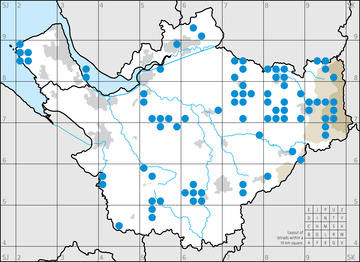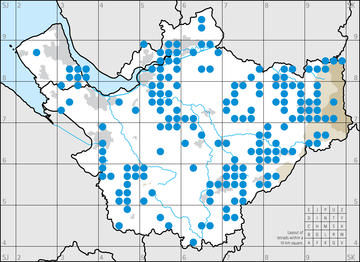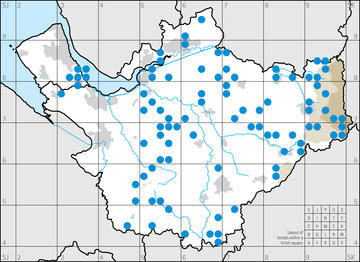
Siskin © Richard Steel
The biennial variation in the natural seed-crop means that in alternate years Siskins tend to stay in woodland, often in quite large flocks and usually in the tops of the trees. In these years many birds move north to their breeding grounds without visiting gardens and feeding stations. Some birders describe this as ‘a bad year for Siskins’, but it is actually the opposite: natural feeding conditions were so good for the species that they had no need of artificially-provided food, and migrated north to breed earlier than normal.
This alternate-year pattern is shown well in the records for this Atlas, and parallels that found for Lesser Redpoll, another finch that feeds on tree seeds; indeed the two species were often found together, especially in waterside alders and birches. In the winters 2004/ 05 and 2006/ 07 Siskins were recorded in 82 and 90 tetrads, whereas in the middle winter, 2005/ 06, they were found in more than twice as many, 189 tetrads. Evidence for the switch between natural food and bird feeders comes from the habitat codes submitted for this Atlas. In 2004/ 05 and 2006/ 07, most of the habitat records (51%) were from woodland, with 33% from human sites; in 2005/ 06, their habitat choice was reversed, with 39% in woodland and 53% of records in human sites.
Siskins are nearly always found in flocks. Of the 266 counts submitted, half of them were of ten birds or more, and eight tetrads recorded flocks of 100 or more. As well as being far more widespread in 2005/ 06, far more Siskins were counted in the middle winter, again more in total than the other two winters put together.
Many of the county’s ringers have concentrated on this species, the results showing that there are two populations of Siskins wintering here, from breeding areas in continental Europe and in Scotland. These different groups appear to intermingle and are indistinguishable in the field, or in the hand. It is not known where our local breeding birds spend the winter.
Although Siskins are now much more numerous, the species’ behaviour has obviously not changed much in more than a century. Coward (1910) wrote that the ‘Siskin is only known in Cheshire as a winter visitor, sometimes occurring in considerable numbers, but in some seasons being scarce or absent … almost invariably met with in compact flocks in alders and birches, feeding upon the seeds’, and fifty years later, Bell (1962) repeated this statement of their status. The annual county bird reports from 1964 on, however, record no years when Siskins were absent. The number of reports, and of birds, increased considerably from the 1970s as Siskins adopted a new habit of visiting gardens and feeding on peanuts, with most birds now preferring niger seed when it is on offer.

Siskin in winter 2004/05.

Siskin in winter 2005/06.

Siskin in winter 2006/07.
Sponsored by David Simmons

